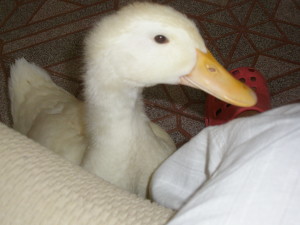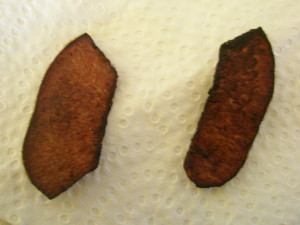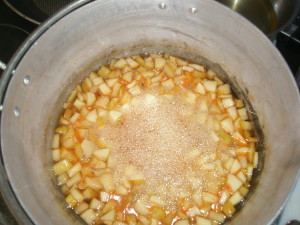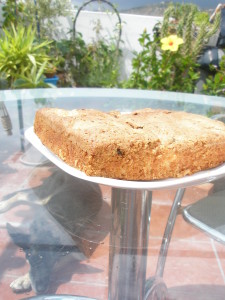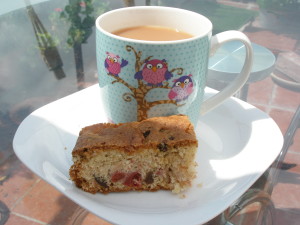Click here for a song that is almost relevant!
When cooking quince with duck, it is essential to have on hand a mop and bucket, a brush and dustpan, and plenty of hot, soapy water. More of that later…
Having been given a couple of bags of quinces (thank you Sandra) I set about finding interesting things to do with them. Inspired by Paul Simon and the tantalising glimpse of a possible bi-lingual pun, I hoped it might be possible be possible to find fifteen.
The last time I remember having any close contact with quinces would have been in the early eighteen hundreds, when my mother was given a bag of them. She was grateful for the kindness of the donor, but had no idea whatsoever what to do with them. I have a vague recollection of her attempting to make quince jelly, probably involving a panic when she realised she had nothing in which to strain it, and her and my father expressing disappointment that it was rather tasteless.
Of course, this was before the days of the glorious internet. Having tried looking through my huge Good Housekeeping Cookbook and an ancient giveaway cookbook from Stork Margarine, I can see why my mother might have felt at somewhat of a loss. My not very representative sample of English cookery books shows an eerie void where quince should be in the index.
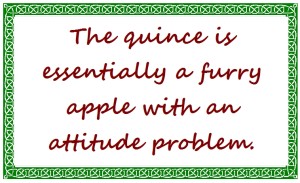
Via the wonders of a quick google search, I confirmed to myself that the inner structure of a quince was similar to that of an apple or pear. Indeed, sources seemed to suggest that the quince is essentially a furry apple with an attitude problem. *
“They are very tough,” warned one, “and care should be taken when using sharp knives.” Another helpful site told me that their cores tend to hide in unexpected places, and that peeling them is nigh on impossible.
I decided that quinces were probably misunderstood, and that they just needed the love of a good woman to bring out their hidden, unappreciated loveliness. So without further ado, I took a quince from the bag, and set about experimenting.
I can confirm that quinces are furry. My sample quince was covered in a soft, slightly mangey-looking, orangey-yellowy bum fluff. I can also confirm that quinces are very difficult to peel. My favourite, heroically sharp, tough and generally excellent peeler could hardly even penetrate the skin, and juddered painfully on the woody flesh beneath. I remembered that some of the internet articles I had seen suggested that it is not necessary to peel quinces. Substitute ‘possible’ for ‘necessary’ and they might be a little nearer the truth!
A different approach was clearly required, so I emptied all the quinces into the sink, and scrubbed off the fluff with an old pan scrubber. It came off very easily, and revealed glossy, smooth fruit, somewhat similar in colour to a Granny Smith apple.
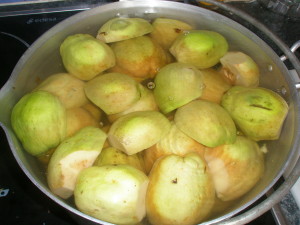 I have found that blanching tomatoes makes removing the skin a complete doddle. Would blanching quinces be equally effective? The simple answer is no. After five minutes, my pan of quinces were still impenetrable, so I chopped them in half with difficulty and much muttering and set them to boil for about half an hour more, while I filled the slow cooker with the ones that would not fit in the preserving pan.
I have found that blanching tomatoes makes removing the skin a complete doddle. Would blanching quinces be equally effective? The simple answer is no. After five minutes, my pan of quinces were still impenetrable, so I chopped them in half with difficulty and much muttering and set them to boil for about half an hour more, while I filled the slow cooker with the ones that would not fit in the preserving pan.
Exhausted by my exertions, I had no desire to go another round with the boiled quinces, so I plunged them in cold water, and when they were cool, bagged them up and stuffed them in the fridge. “Give them a night in the cooler, and they’ll be ready to behave in the morning.” I thought, grimly.
Morning dawned dull and overcast. The kitchen was cooler than it has been of late, so I set to work in fine good humour. The slow cooker, which I had forgotten, was full of deep brown, soft fruit that had held their shape, and were looking as if they had potential. Subsequent investigation suggests that slow-cooking quince in Cómpeta wine and serving the result with natural yoghurt and honey would be fairly sublime. I decided to leave the slow-cooked quinces alone for the time being and tackle the huge bag of boiled ones.
Because Dick van Duck is inclined to get under my feet, and to drop ducky deposits around the place, I developed a cunning plan: I would barricade the kitchen door with a folding wooden chair tipped on its side. That way, Dick could putter about on the roof terrace, but he would be able to see into the kitchen, and know where I was. Simple! But not as simple as Dick found it to shin over the barricade. I picked him up, put him firmly outside again and added a watering can and a small bin to the fortifications. Before I had even picked up the knife to chop a quince or two, Dick was over the ramparts and standing at my side.
After ten minutes of increasingly complex and equally useless entrenchments, I capitulated and took the quinces and the chopping board outside. As I stood chopping them up, Dick nestled happily onto one of my crocs, tucked his beak behind his wing and went to sleep.
The quinces were still a consistency somewhere between an apple and a swede, but I found that by cutting the halves into quarters, I could remove the cores with relative safety and minimal loss of digits. They were about as easy to peel as a potato, so I was quite satisfied that boiling was the way to go in future.
I had given up all hope of keeping Dick outside while his ‘mum’ was inside, so once I had chopped all I wanted to chop, we reconvened in the kitchen. Some of the quinces went into the preserving pan with sugar, chillies, ginger and pimenton. I had no idea what the result would be, but it seemed worth a try. The result was some candied spicy quince and a pretty red syrup, which I have cooled and plan to use when the opportunity arises. The candied quince seems a good prospect for recipes that include mixed dried fruit, like fruit cake and hot cross buns.
As we are running very short of nispero chutney, an experiment with vinegar and assorted bits and bobs seemed in order. The quince is a delicately flavoured beast, so I decided to use it as the bulk of the chutney, while adding stronger flavours for interest. Dick helped by sitting on my feet, pooping regularly and tipping over my bucket of vegetable peelings. The kitchen became somehow schizophrenic: above two feet, it was an ordered laboratory where possibly delicious experiments hubbled and bubbled; below two feet it was toil and trouble, strewn with garlic and onion skins, ginger and carrot peel and duck-related detritus. I lost count of the times I broke off to clean up Dick’s mess, mop the floor and scrub my hands.
By the time the chutney was all safely bottled, Dick had worn my patience thin enough that I was considering duck and butter-fried quince recipes, so I took him and put him in his cage downstairs. Fortunately, he had tired himself out being a web-footed Johnny to my Fanny Craddock, and he settled quickly for a nap.
The chutney jury is out at the moment, but when sufficient time has elapsed to come to a verdict, I will report back, if there is anything worth sharing.
My final experiment of the day was a quince and sultana loaf. Knowing that carrots, courgettes and beetroot can all be successfully incorporated into cakes gave me confidence. My oven is unpredictable at best, but I was determined to give it a go.
An hour and a half later, two golden and rather tasty articles were cooling on the cake rack. We tried some last night with cream. Tonight I plan to serve some with poached quince and ice-cream, drizzled with spicy quince syrup.
For anyone who has a quince or two to play with, (I suspect apples, pears or bananas would work equally well) here is the recipe:
Quince and sultana loaf/cake
A 3 cups flour
B 1tsp baking powder
C 1tsp salt
D 1 cup sultanas
E. 3 cups chopped quince
F 1 cup melted margarine
G 2 cups sugar
H 3 eggs
I 1tsp ground cinnamon.
(I use a Tupperware beaker as a cup for measuring the quantities. It holds about 250 ml when filled to the level you would fill a cup of tea.)
Preheat oven to 160 degrees
Mix A-E together
Mix F-I together
Pour wet into dry and mix until combined
Pour into lined tins -2 small loaf tins or equivalent – and bake until a toothpick stuck into the middle comes out clean. (About 1hr to 90 minutes depending on the tin and oven used)
Cool in tins for 10 mins, then on a wire rack to completely cool.
Enjoy!
* The quince is actually a yob of a fruit, which thinks it is well hard. It sits on the chopping board with a ‘go on then, if you think you can take me’ smirk. Of course, it is possible that my quinces were slightly under ripe, but in my opinion, that is no excuse for being uncouth and ill-mannered.


